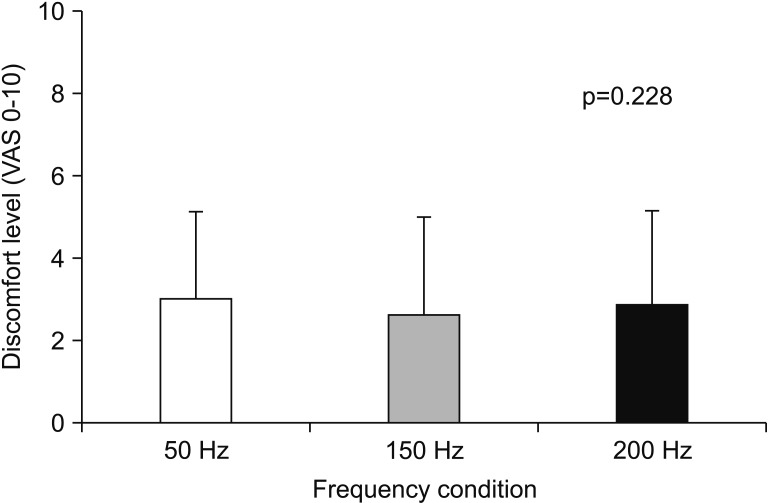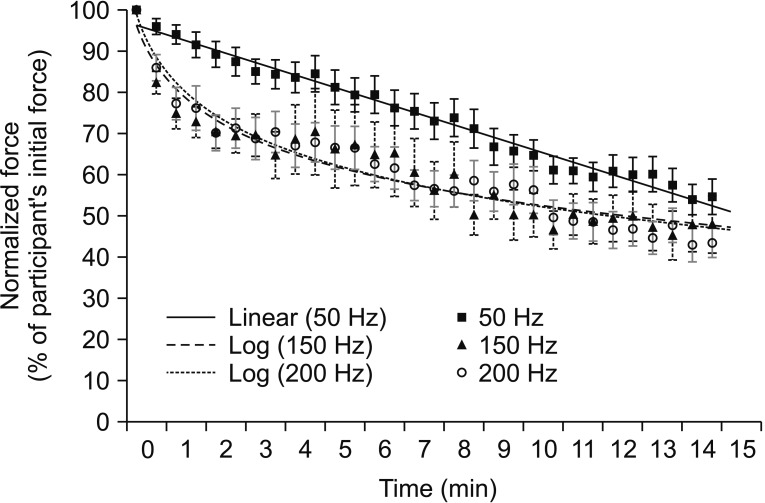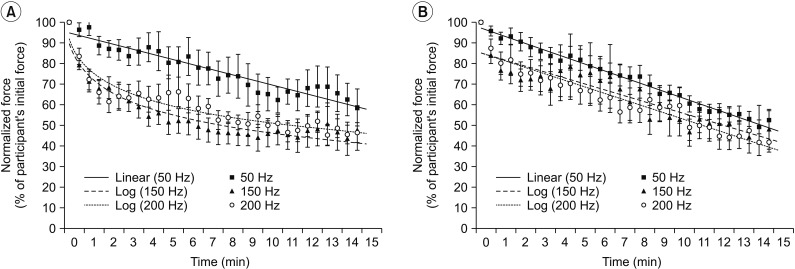Ann Rehabil Med.
2018 Apr;42(2):250-259. 10.5535/arm.2018.42.2.250.
Effects of Very High Stimulation Frequency and Wide-Pulse Duration on Stimulated Force and Fatigue of Quadriceps in Healthy Participants
- Affiliations
-
- 1Department of Physical Therapy, Faculty of Associated Medical Sciences, Chiang Mai University, Chiang Mai, Thailand. jonjin.r@cmu.ac.th
- KMID: 2432195
- DOI: http://doi.org/10.5535/arm.2018.42.2.250
Abstract
OBJECTIVE
To determine the effect of very high stimulation frequency (150 and 200 Hz) with wide pulse duration versus 50 Hz with wide pulse duration on stimulated force and fatigue of quadriceps femoris in healthy participants.
METHODS
Thirty-four healthy participants underwent fatigue test using three stimulation frequency conditions (50, 150, and 200 Hz) with pulse duration of 0.9 ms. Normalized force values at the end of each fatigue protocol and curve fitting patterns were compared among stimulated frequencies.
RESULTS
Very high stimulation frequency (150 and 200 Hz) conditions showed a trend of having more decline in normalized stimulated force during fatigue test compared to a low stimulation frequency at 50 Hz. However, the difference was not statistically significant. Responder group showed the same slope of a linear fitting pattern, implying the same pattern of muscle fatigue among three stimulation frequency conditions (−3.32 in 50 Hz, −2.88 in 150 Hz, and −3.14 in 200 Hz, respectively).
CONCLUSION
There were high inter-subject variations in the response to different frequency stimulation conditions. However, very high stimulation frequency generated the same fatigue pattern as the low stimulation frequency in the responder group. Further research is needed to explore the mechanism involved.
MeSH Terms
Figure
Reference
-
1. Glanz M, Klawansky S, Stason W, Berkey C, Chalmers TC. Functional electrostimulation in poststroke rehabilitation: a meta-analysis of the randomized controlled trials. Arch Phys Med Rehabil. 1996; 77:549–553. PMID: 8831470.
Article2. Yan T, Hui-Chan CW, Li LS. Functional electrical stimulation improves motor recovery of the lower extremity and walking ability of subjects with first acute stroke: a randomized placebo-controlled trial. Stroke. 2005; 36:80–85. PMID: 15569875.3. Currier DP, Mann R. Muscular strength development by electrical stimulation in healthy individuals. Phys Ther. 1983; 63:915–921. PMID: 6856678.
Article4. Laughman RK, Youdas JW, Garrett TR, Chao EY. Strength changes in the normal quadriceps femoris muscle as a result of electrical stimulation. Phys Ther. 1983; 63:494–499. PMID: 6601279.
Article5. Gorgey AS, Mahoney E, Kendall T, Dudley GA. Effects of neuromuscular electrical stimulation parameters on specific tension. Eur J Appl Physiol. 2006; 97:737–744. PMID: 16821023.
Article6. Gregory CM, Dixon W, Bickel CS. Impact of varying pulse frequency and duration on muscle torque production and fatigue. Muscle Nerve. 2007; 35:504–509. PMID: 17230536.
Article7. Dreibati B, Lavet C, Pinti A, Poumarat G. Influence of electrical stimulation frequency on skeletal muscle force and fatigue. Ann Phys Rehabil Med. 2010; 53:266–271. PMID: 20430713.
Article8. Kesar T, Binder-Macleod S. Effect of frequency and pulse duration on human muscle fatigue during repetitive electrical stimulation. Exp Physiol. 2006; 91:967–976. PMID: 16873456.
Article9. Van Cutsem M, Duchateau J, Hainaut K. Changes in single motor unit behavior contribute to the increase in contraction speed after dynamic training in humans. J Physiol. 1998; 513(Pt 1):295–305. PMID: 9782179.10. Christie A, Kamen G. Doublet discharges in motoneurons of young and older adults. J Neurophysiol. 2006; 95:2787–2795. PMID: 16452261.
Article11. Abbate F, Sargeant AJ, Verdijk PW, de Haan A. Effects of high-frequency initial pulses and posttetanic potentiation on power output of skeletal muscle. J Appl Physiol (1985). 2000; 88:35–40. PMID: 10642359.
Article12. Malesevic NM, Popovic LZ, Schwirtlich L, Popovic DB. Distributed low-frequency functional electrical stimulation delays muscle fatigue compared to conventional stimulation. Muscle Nerve. 2010; 42:556–562. PMID: 20665516.
Article13. Popovic LZ, Malesevic NM. Muscle fatigue of quadriceps in paraplegics: comparison between single vs. multi-pad electrode surface stimulation. Conf Proc IEEE Eng Med Biol Soc. 2009; 2009:6785–6788. PMID: 19964709.
Article14. Bergquist AJ, Wiest MJ, Collins DF. Motor unit recruitment when neuromuscular electrical stimulation is applied over a nerve trunk compared with a muscle belly: quadriceps femoris. J Appl Physiol (1985). 2012; 113:78–89. PMID: 22556395.
Article15. Knikou M. The H-reflex as a probe: pathways and pitfalls. J Neurosci Methods. 2008; 171:1–12. PMID: 18394711.
Article16. Misiaszek JE. The H-reflex as a tool in neurophysiology: its limitations and uses in understanding nervous system function. Muscle Nerve. 2003; 28:144–160. PMID: 12872318.
Article17. Dideriksen JL, Muceli S, Dosen S, Laine CM, Farina D. Physiological recruitment of motor units by highfrequency electrical stimulation of afferent pathways. J Appl Physiol (1985). 2015; 118:365–376. PMID: 25477350.
Article18. Dean JC, Yates LM, Collins DF. Turning on the central contribution to contractions evoked by neuromuscular electrical stimulation. J Appl Physiol (1985). 2007; 103:170–176. PMID: 17463296.
Article19. Clair-Auger JM, Collins DF, Dewald JP. The effects of wide pulse neuromuscular electrical stimulation on elbow flexion torque in individuals with chronic hemiparetic stroke. Clin Neurophysiol. 2012; 123:2247–2255. PMID: 22627022.
Article20. Binder-Macleod SA, Scott WB. Comparison of fatigue produced by various electrical stimulation trains. Acta Physiol Scand. 2001; 172:195–203. PMID: 11472306.
Article21. Guyton AC, Hall JE. Textbook of medical physiology. 11th ed. Philadelphia: Elsevier Saunders;2006.22. Borg J. Refractory period of single motor nerve fibres in man. J Neurol Neurosurg Psychiatry. 1984; 47:344–348. PMID: 6726259.
Article23. Kimura J, Yamada T, Rodnitzky RL. Refractory period of human motor nerve fibres. J Neurol Neurosurg Psychiatry. 1978; 41:784–790. PMID: 690648.
Article24. Willems ME, Ponte JP. Divergent muscle fatigue during unilateral isometric contractions of dominant and non-dominant quadriceps. J Sci Med Sport. 2013; 16:240–244. PMID: 22819255.
Article25. Neyroud D, Dodd D, Gondin J, Maffiuletti NA, Kayser B, Place N. Wide-pulse-high-frequency neuromuscular stimulation of triceps surae induces greater muscle fatigue compared with conventional stimulation. J Appl Physiol (1985). 2014; 116:1281–1289. PMID: 24674861.
Article26. Oyewole SA. Enhancing ergonomic safety effectiveness of repetitive job activities: prediction of muscle fatigue in dominant and nondominant arms of industrial workers. Hum Factors Ergon Manuf Serv Ind. 2014; 24:585–600.
Article27. Adams GR, Harris RT, Woodard D, Dudley GA. Mapping of electrical muscle stimulation using MRI. J Appl Physiol (1985). 1993; 74:532–537. PMID: 8458767.
Article28. Wegrzyk J, Foure A, Vilmen C, Ghattas B, Maffiuletti NA, Mattei JP, et al. Extra Forces induced by widepulse, high-frequency electrical stimulation: occurrence, magnitude, variability and underlying mechanisms. Clin Neurophysiol. 2015; 126:1400–1412. PMID: 25454283.
Article29. Papaiordanidou M, Stevenot JD, Mustacchi V, Vanoncini M, Martin A. Electrically induced torque decrease reflects more than muscle fatigue. Muscle Nerve. 2014; 50:604–607. PMID: 24797162.
Article30. Martin A, Grospretre S, Vilmen C, Guye M, Mattei JP, LE Fur Y, et al. The etiology of muscle fatigue differs between two electrical stimulation protocols. Med Sci Sports Exerc. 2016; 48:1474–1484. PMID: 27031743.
Article31. Baldwin ER, Klakowicz PM, Collins DF. Wide-pulsewidth, high-frequency neuromuscular stimulation: implications for functional electrical stimulation. J Appl Physiol (1985). 2006; 101:228–240. PMID: 16627680.
Article32. Collins DF. Central contributions to contractions evoked by tetanic neuromuscular electrical stimulation. Exerc Sport Sci Rev. 2007; 35:102–109. PMID: 17620928.
Article33. Wegrzyk J, Foure A, Le Fur Y, Maffiuletti NA, Vilmen C, Guye M, et al. Responders to wide-pulse, high-frequency neuromuscular electrical stimulation show reduced metabolic demand: a 31P-MRS study in humans. PLoS One. 2015; 10:e0143972. PMID: 26619330.
Article34. Russ DW, Vandenborne K, Walter GA, Elliott M, Binder-Macleod SA. Effects of muscle activation on fatigue and metabolism in human skeletal muscle. J Appl Physiol (1985). 2002; 92:1978–1986. PMID: 11960948.35. Matsunaga T, Shimada Y, Sato K. Muscle fatigue from intermittent stimulation with low and high frequency electrical pulses. Arch Phys Med Rehabil. 1999; 80:48–53. PMID: 9915371.
Article36. Kesar T, Chou LW, Binder-Macleod SA. Effects of stimulation frequency versus pulse duration modulation on muscle fatigue. J Electromyogr Kinesiol. 2008; 18:662–671. PMID: 17317219.
Article37. Jørgensen L, Jacobsen BK. Changes in muscle mass, fat mass, and bone mineral content in the legs after stroke: a 1 year prospective study. Bone. 2001; 28:655–659. PMID: 11425655.
Article
- Full Text Links
- Actions
-
Cited
- CITED
-
- Close
- Share
- Similar articles
-
- The Effect of an Abdominal Drawing-In Maneuver Combined with Low·High Frequency Neuromuscular Electrical Stimulation on Trunk Muscle Activity, Muscle Fatigue, and Balance in Stroke Patients
- The Clinical Applications and the Electroencephalogram Effects of Repeated Transcranial Magnetic Stimulation
- The Effect of Paraffin Treatment with Exercise on Muscle Strength and Fatigue of the Hand According to the Use of Smartphone
- Influence of Transcutaneous Electrical Nerve Stimulation on Cutaneous Silent Period
- Factors Influencing on Fatigue in Patients with Epilepsy




